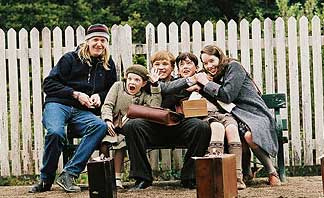 Andrew Adamson sort of looks like Steve Buscemi. Just an observation.
Andrew Adamson sort of looks like Steve Buscemi. Just an observation.
Adamson makes his live action directorial debut with Chronicles of Narnia: The Lion, The Witch and The Wardrobe, playing every place you can possibly imagine this Friday. You may have seen his earlier films, Shrek and Shrek 2. I heard they were moderately well received at the box office.
It’s been a long road to get to the press junket for Adamson, and I don’t just say that because he’s from New Zealand. Narnia had an audition process that spanned almost 18 months. And then there was the filming, and then the complicated post-production FX work that filled the world with monsters and ice castles and talking beavers. But if he was tired, Adamson wasn’t showing it – he was more than happy to talk about the film. He wasn’t more than happy to talk about the Christianity aspect, though. He still talked about it anyway.
Q: What made you choose this film for your live action debut?
Adamson: The fact that I grew up with it as a child, I fell in love with this story, this world. I read the book at eight years old, and I read all seven of them and reluctantly got the end of the last one thinking ‘I’m going to have to start all over again.’
Q: Had you seen the animated version?
Adamson: I saw that when I was young and I went back and saw it again as an adult, and the interesting thing about it, I wouldn’t say it was well made, but the interesting thing, they made some decisions that were strange and yet I understand- for instance, Mr. Tumnus was dancing around on the lamppost being incredibly silly- and at the same time I know the goal was to liven up the story, which is a somber book in many ways, and I had the same challenge. What intrigued me about the animated version was seeing it as an adult, what I found reassuring is that it still works on an emotional level. You get to the point where Aslan is going to his death, and as crude as that animation is, you still feel the emotion. And that was reassuring. It’s going to hard to screw it up, basically. It’s very reassuring.
Q: You’ve said your goal was to tell the story as you remembered it. Why?
Adamson: I sat down and wrote down- before I reread it, because I didn’t want to be disillusioned by rereading it, so to speak- I tried to write down everything I could remember about it from reading it as a child, and then I sat down and reread it, and it was kind of like going back to the house I grew up in. The book was smaller than I remembered it. CS Lewis wrote in a way that he relies on your imagination. As a child, you fill out the imagery. And it was that imagery that I wanted to put on the screen. The battle is very brief, it’s basically 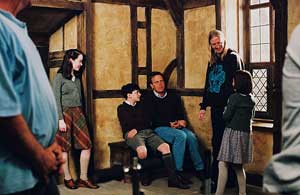 Peter telling Aslan what happened when he was away. And yet somehow in my mind I had this impression of this great battle- probably because I read all of the books. I remembered it as an epic story, and I wanted to tell the movie as an epic story.
Peter telling Aslan what happened when he was away. And yet somehow in my mind I had this impression of this great battle- probably because I read all of the books. I remembered it as an epic story, and I wanted to tell the movie as an epic story.
Q: Lewis made choices to give children access to the story. How did you go about doing that?
Adamson: Film is such a visual medium, film is a visual experience, and if you’re in the position where you have to live up to or exceed people’s expectations, it’s always a scary thing. There’s always a fear that my impression or my imagination made it different than someone else’s. Am I limiting, meeting, exceeding everyone else’s expectations?
It really comes down to the question- should this be made into a film or not? For me personally, it was too good of an opportunity to be able to realize some of my boyhood dreams, but also to share my impressions of the book. I think ultimately if someone’s worried about that they shouldn’t see the film. But I have been reassured by people along the way that I am meeting their expectations. Even Douglas Gresham, C.S. Lewis’ stepson, who’s lived with this book all his life, would come on the set and tear up at times and say ‘this is exactly how I imagined it.’ So I tried as much as possible to tap into as much of the universal impression of the book as I could.
Q: Do you prefer using your imagination to adapting a book like Lord of the Rings in which everything was spelled out?
Adamson: CS Lewis spent more time describing the meals than most other things, that…it’s a blessing and a curse. It’s great that I get to use my imagination. It’s great that I get to draw upon my childhood, at the same time it carries that danger that we’re just discussing. I guess I do prefer it because I like existing in my own imagination, as a film maker I like taking things out of my head and being able to share them with other people.
Q: What was it like to watch the film come together?
Adamson: It’s great- but this is the sad thing about making the film yourself- you never get to completely enjoy it as a naïve experience. You never get to walk in and believe it because you know all the elements that went into it. That being said, I still feel the emotion of watching the film even now. And there’s certain moments- I don’t know if it’s because I know the children and I know their emotional state- like the moment Lucy comes and finds Mr. Tumnus turned to stone and she cries, I know that was Georgie projecting her impression of what would happen if James was turned to stone. So I know that emotion was real, and I tear up. Some of the other things- Aslan’s death on the stone table- I find hard to be emotional about because that’s a very technical scene and I’ve watched that scene hundreds of times. Sometimes with an audience I can still have that experience, but most of the time I’m going oh, I wish I’d done different lighting on that bauble in the background. So it’s harder for me to enjoy it that way. Maybe ten years from now I will. I caught Shrek on TV one day, I was flipping through the channels and I saw some colors that looked interesting and I stopped and said, “That’s why I like those colors, I put them there!” And I watched the film and really just enjoyed it as an audience member for the first time in a number of years.
Q: It’s funny that you mention Shrek because in that film you really skewer a lot of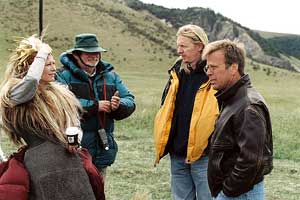 fantasy stuff.
fantasy stuff.
Adamson: It’s fun to move from irreverence to reverence. One of the things I brought forth was I made this a story about family. And Shrek 2 is a story about family. So even though the stories are very different and you’re making them in a different way and using different techniques, they’re still stories about human conditions and human situations. And to me this is a family drama taken to epic proportions.
Q: Would you consider Narnia a fairy tale?
Adamson: Some people saw them as fairy tales, I never saw them that way. I don’t know if it’s because I was exposed to them at a very young age, but I always believed that Narnia was a real place. And the Hans Christian Anderson stories- maybe because they were smaller and more contained and this is a whole world in over seven books, I never saw Narnia as the same thing.
Q: What makes it such an important story?
Adamson: The themes of forgiveness and sacrifice, which are universal themes and have stood the test of time. And I think why it appeals to people on a personal level…I had someone say to me the other day when they saw Lucy step through the wardrobe, it didn’t just make them remember what it was like to be a child, it made them nostalgic for their childhood. I think we lose so much of that as we get older, and for an adult reading the book, it’s nice to invoke that. For children, I think, it’s a story of empowerment. They’re not children when they go to Narnia, they’re kings and queens. In England, they’re disenfranchised, and have no control over this war; in Narnia, they’re the only ones who have control over this war.
Q: It still resonates today- for what reason?
Adamson: Because children are just as disempowered today. We are lucky, or at least I am- I never grew up in a war, I never experienced that level of disempowerment. In this world (Narnia), everyone’s waiting for them to tell them what to do. It’s a lot of responsibility, but with responsibility comes control and power.
Q: Big battle scenes are clichés at this point. What did you do to make this one special?
Adamson: It is inevitable that when you have a battle with swords, there’s going to be some commonality, but I was lucky enough to have a menagerie of creatures to deal with. I could have birds and griffins and phoenixes coming down, I could have centaurs fighting men on horseback. All of them were make believe, I designed them and used them in different ways.
Q: In the book the battle is just described-
Adamson: Barely described.
Q: And this is your imagination?
Adamson: Mine and many other people who collaborated on it. It was something we started designing very early on, and it actually looked the battle from the battle of (inaudible). I remember seeing that film and thinking it was an emotional story. Yes, they were epic battles, but it was a story about the characters. And I wanted to make this a story about Peter and Edmond, and still make it on an epic scale.
Q: Is the rivalry between Dreamworks and Disney as bad as it’s been portrayed?
Adamson: It was funny, I started this in the middle of Shrek 2, I was working for both studios. The rivalry is much more interesting in the press than it is in reality. They’re very similar- Jeffrey Katzenberg came from Disney, he brought the same family attitude to Dreamworks, so to me it didn’t seem odd. They’re close physically so to me it didn’t take long to drive from one place to the next.
Q: Why did you begin the film in war-torn London?
Adamson: It’s from a line in the book that says… “they were sent away from London during the war because of the air raids.” what I wanted to do was set context, give it a sense of reality. Before I took the audience into this fantasy world, I wanted to give them a sense of these children in jeopardy, and explain why they are having problems. Edmond isn’t just a bad 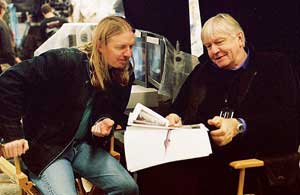 boy, he’s a bad boy in the movie because his father’s away at war, his brother’s pushing him around, doing a bad job of being an authority figure. I also wanted to say to the audience at the beginning, this is a different version of The Lion, the Witch, and the Wardrobe. This is a big story. People come into the film expecting to see four kids in a house- that would feel like a small British story. I really wanted to say, “no it’s not,” wake everyone up.
boy, he’s a bad boy in the movie because his father’s away at war, his brother’s pushing him around, doing a bad job of being an authority figure. I also wanted to say to the audience at the beginning, this is a different version of The Lion, the Witch, and the Wardrobe. This is a big story. People come into the film expecting to see four kids in a house- that would feel like a small British story. I really wanted to say, “no it’s not,” wake everyone up.
Q: With Mr. Tumnus…it would have been easy to make that really creepy- a shirtless guy, hanging out with a little girl.
Adamson: That scene was the hardest one to write, we wrote hundreds of versions of that scene, and ultimately the thing that made it work was James McAvoy. Mr. Tumnus can be read in the book as a doddering old English guy. And James put himself on tape, and he was the only person who understood- it was a blind audition, I hadn’t talked to him- who understood the moral agenda, the political dilemma. He knew what he should do to save his own skin, but at the same time had this moral dilemma of meeting a human for the first time and realizing that Lucy was good. So it was challenging, but I also think it was because James is a warm person and his warmth comes across, and because Georgie and James had such a close friendship that it doesn’t feel creepy. And I would have kept rewriting that until I heard James read it. And then I went, “we’re going to be ok.” And he was in the middle of a lot of projects. We really had to work to get him over there, to get him fitted, to get all the prosthetics down.
Q: You used a ton of practical monsters, and it was so neat to see minotaurs really there. What made you decide to go practical?
Adamson: In some ways it’s the easiest way to do it, but the other thing is, sometimes if you see something physical, and you cut away to a CG thing that looks very close to the physical thing, you never know quite what you’re looking at. The more you can keep the audience guessing as to how you did it, the less they actually think about how you did it.
Q: Can you speak to the film’s Christian allegory…Disney is selling this to a specific Christian base.
Adamson: I love how in the press- Disney wants everyone to see this film, they’re aiming it at everyone you can think of.
Q: There is a special Christian soundtrack.
Adamson: That’s an inspired album. An album inspired by the book. The other album is the album of the movie, that really is my music.
Q: Harry Gregson- Williams?
Adamson: Harry Gregson, yes. So I think there are a lot of people who have been inspired by the book, and the book has had a huge influence on Christians. I always thought we were trying to appeal to all the fans of the book. There was a lot of concern throughout the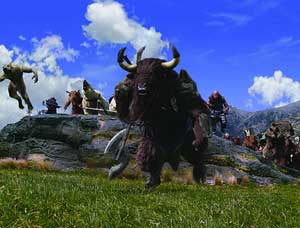 process as there was with Lord of the Rings that we do something true to the book, and I think Disney feels very responsible for that, reassuring fans of all religions.
process as there was with Lord of the Rings that we do something true to the book, and I think Disney feels very responsible for that, reassuring fans of all religions.
Q: Are you worried press is picking up on it too much?
Adamson: Yeah, I’m worried about why you guys are all so obsessed with it! The better story is- why are you all so obsessed with it? Are you trying to create – in order to sell their papers?
Q: Can you talk about the casting of the kids?
Adamson: It was my first time working with children, and that was a daunting thing. I wanted very real children, and I went to Pippa Hall, who found Jamie Bell for Billy Elliot, did such a great job of casting a real kid who was like the character he was playing. And that’s what I wanted to do- find real children who were like the characters I imagined, so it wasn’t so much about acting as it was about being themselves. It was an eighteen month search, I looked at 2500 kids on tapes, I work shopped 400 kids in groups and 120 more directly. I met William and Anna right at the beginning- I met Anna when she was thirteen, and she turned sixteen during filming. And I was just hoping they didn’t grow too much. I met Skandar towards the end, Georgie somewhere towards the middle of it. It was challenging, but at the same time, when I met each kid I knew straight away that they were the right fit for the roles.
Q: What did you do in those workshops?
Adamson: I started playing with some of the scenes, and then I decided I wanted to do things like the scenes to keep the spontaneity when it came to shooting the scenes. One of the things is that Skandar is an incredibly resilient child, and I didn’t know if I could ever get him to cry. So in one of the workshops we played out the scene where he ran back to get the photo of his father, we played out something before that where I set him and William against each other and just really let them get on each other’s nerves to the point where Skandar got really frustrated, and it was a really amazing experience because Georgie and Anna were still there in the workshop watching and I didn’t know if Georgie wanted to be there and she said she wanted to stay. And Skandar got himself to this emotional state and I let them run into the scene- like an improv, running into the scene. And it played really well, and we did the same thing when we shot it. And at the end of it, Georgie was sitting there looking shell shocked and I said, “do you want to give your mom a hug?” And she cried, it was all very emotional, and all the kids came away totally excited. Anna said to her mom afterwards that she would trust me to do any of these scenes. And I think they all discovered that if they could find a place of reality it would carry them through the film. And we did a lot of improv, start them off with a scenario and get them to the right emotional state, then go into the scene.
Q: What happened with Brian Cox? He was originally the voice of Aslan.
Adamson: He was…he was very nice about it. We both agreed at some point that it wasn’t working. He helped me find the character, because I didn’t know the character when we cast Brian. I always rewrite after I find actors because they inform the roles so much. There was a limitation to the character that Brian was struggling with.
Q: Which was?
Adamson: Lack of humanity. He’s a very omnipotent character and yet I wanted him to be accessible, I wanted him to be vulnerable. And I hadn’t found that the first time I recorded with Liam, but the first time I recorded with Liam I heard the warmth in his voice, and I said I wanted to find out what Aslan was like on his day off. When he put up his feet and watched TV. Because you have to know someone as a person to feel sympathy for them. Which is why I added some humor for Aslan- small moments, like the one he has with Peter up on the hill. If you can make him more accessible, you can care about him.
Q: Edmund can be rotten, but the audience has to like him. How did you balance that?
Adamson: It was something I was worried about, and I have to attribute a lot of that to Skandar. He is a little brat who you really like. But some of it comes down to explaining why he did it. In the book he was one note, he was just a bad boy. But I tried to look deeper and figure out why he was bad. The reasons are there- his older brother is telling him what to do, a year before that they were probably best buddies. Now he’s pushing him around, and he’s not doing a very good job. So resentment is going to build up. I’m a third child, if my brother was doing that to me and some beautiful woman came along and said I’m going to make you king, you can tell your brother what to do, it’s like, “all right, I’m in, I’m going to betray him.”
Q: What’s next for you?
Adamson: A vacation. I started this movie without a family and now I have two children. One’s two and a half and the other’s two months.
Q: You were busy.
Adamson: I actually deliberately haven’t thought about what I’m doing next because I’ve really overlapped my projects and I’ve never really had the time to have some time to clear my head.
Q: If you came back for a sequel would it be Prince Caspian?
Adamson: I think that’s likely going to be the next film. I’m not entirely sure if I’m going to do it or not- I need to have that clear head space first. It is the same four kids, so it would make sense to do that next before these kids get too old.